



After Magnus Carlsen’s two wins in the first rounds, it was only a matter of time before the pundits in the press room started speculating on him scoring 7/7 (which sounds even more impressive with the ‘football score’ equivalent, 21/21). But that is not going to happen, thanks to a resolute refusal to be ‘magnified’ by England’s David Howell and (it has to be admitted) one golden opportunity missed by Carlsen. The only three-point scorer was Vladimir Kramnik who thus moves up to within one point of the young Norwegian.
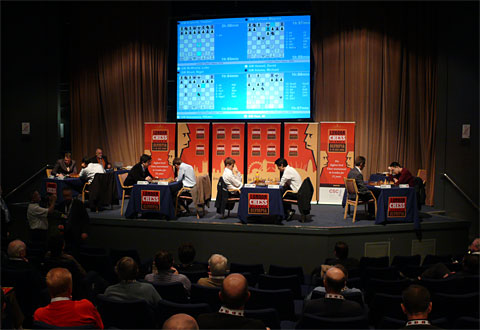
The start of round three in London
This round had two extra dimensions which made it particularly intriguing. One was that it was an ‘England versus the Rest of the World’ match, with four Englishmen paired against a formidable overseas quartet. The second was a sub-division of the first: a clash between the strongest teenage players in the World and England. Could English chess rise to this challenge?

Chinese GM Ni Hau facing...
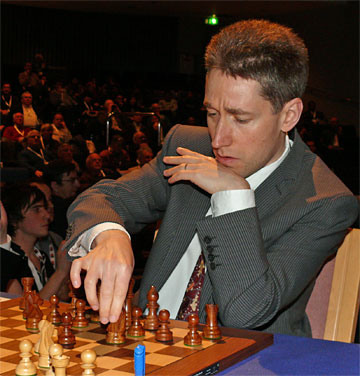
England's Michael Adams in round three
The best hope of a full point for the unofficial ‘England team’ at start of play was probably Michael Adams, playing black against Ni Hua. The Cornishman went in for his favourite Marshall Counter-Attack against the Ruy Lopez. This variation has retained its popularity for more than 90 years. Consequently, a huge body of theory has built up round it and needs to be studied closely before risked in practical play. I’d be inclined to stick a big sign on it reading “experts only”. At first sight play looks quite sharp but the super-GMs tend to know it so well that they can keep things under reasonable control. Around move 16, Michael Adams played a subtle innovation and later offered a second pawn sacrifice which Ni Hua spurned – probably rightly. Adams’ compensation for the pawn was his powerful control of the dangerous long h1-a8 diagonal but Ni Hua was able to exchange most of the pieces on the board and then stop the black rook from penetrating his position. Result: draw.
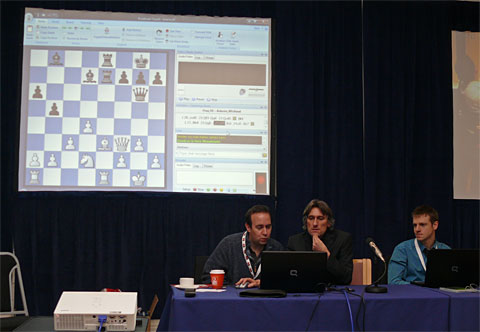
Grandmasters Chris Ward, Daniel King and Stephen Gordon in the commentary
room
analysing Ni Hua vs Adams for spectators and a world-wide Playchess audience
Ni Hua (2665) - Adams,Michael (2698) C89
London Chess Classic London (3), 10.12.2009
1.e4 e5 2.Nf3 Nc6 3.Bb5 a6 4.Ba4 Nf6 5.0-0 Be7 6.Re1 b5 7.Bb3 0-0 8.c3
d5 9.exd5 Nxd5 10.Nxe5 Nxe5 11.Rxe5 c6 12.d4 Bd6 13.Re1 Qh4 14.g3 Qh3 15.Qe2
Bd7 16.Qf1 Qf5 17.Be3 Rae8 18.Nd2 Re7 19.Qg2 Rfe8 20.Qf3 Qg6 21.Bxd5 cxd5 22.a4
bxa4 23.Qxd5 h6 24.Nf3 Qf6 25.Ne5 Bxe5 26.dxe5 Qg6 27.Qd6 Qf5 28.Bd4 Bc8 29.Re3
Bb7 30.e6 Rxe6 31.Rxe6 Qxe6 32.Qxe6 Rxe6 33.Be3 Rd6 1/2-1/2. [Click
to replay]
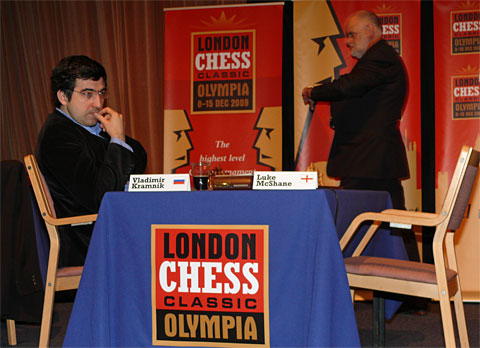
Vladimir Kramnik waiting for Luke McShane, who was caught in London traffic
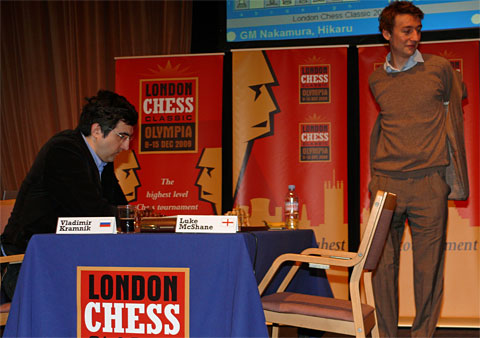
No "zero tolerance" rule in London, when Luke arrives ten minutes
late – in Khanty-
Mansiysk he would have defaulted and Vladimir would not have had to work for
the point.
The tiredness that Luke McShane must have felt after his seven hours 36 minutes’ marathon win against Nigel Short seemed to tell on him in round three when he lost rather a poor game to Vladimir Kramnik. Luke opened with the Bishop’s Opening (1 e4 e5 2 Bc4), which may have been a deliberate attempt to dodge Vladimir Kramnik’s possible Petroff’s Defence had he played 2 Nf3. At least, that was Vladimir Kramnik’s opinion when he talked us through the game in the commentary room. As soon as he said it, Vlad realised that he might have given a big clue to his future opponents as regards his future intentions. He quickly added: “Of course, I’m not saying that I am going to play the Petroff’s Defence!” (with a big smile).
McShane,Luke (2615) - Kramnik,Vladimir (2772) C24
London Chess Classic London (3), 10.12.2009 [John Saunders]
1.e4 e5 2.Bc4. The Bishop's Opening was known to the 16th pioneers of chess (as we know it). It is not fashionable at the higher levels of the game. Though there is nothing specifically wrong with it (and it often transposes into better known openings), it lacks the sort of bite that the super-GMs look for when playing White. 2...Nf6 3.d3 Bc5. 3...c6 is another move often seen here, planning to drive back the c4 bishop with d7-d5. One snag with the Bishop's Opening is that it doesn't oblige Black to play Nc6 to defend his e-pawn; consequently, Black has a little extra flexibility of choice. 4.Nf3 0-0 5.Nc3. Snatching a pawn with 5.Nxe5? is unthinkable at this level. The game might proceed 5...d5 6.exd5 Re8 7.d4 Bxd4! (looks clever but most experienced players at club level would know this trick) 8.Qxd4 Nc6 and White is struggling. Elite players would dismiss such a continuation within nanoseconds, but Vlad Kramnik was kind enough to take the trouble to show us this variation in the commentary room. He is a relaxed and entertaining commentator, striking exactly the right note with his audience. 5...d6 6.Na4. If you've got one of those old Fred Reinfeld chess books for near-beginners, he would probably tell you that all White's problems stem from this - making two moves with the same piece in the opening. Well... on this occasion, I would be inclined to agree. This looks insipid to me. 6...Bb6 7.c3 Be6 8.Bb3. If 8.Bxe6 fxe6 , the doubled pawns aren't much of a problem for Black. He can usually even them out later on by playing d7-d6 and he gets an open file for his f8 rook into the bargain. 8...Bxb3 9.axb3. Again, the argument in favour of doubling the pawns is to give the rook some scope. 9...Nbd7 10.b4
|
White's opening has not been a success but now Black plays rather a surprising move. 10...Bxf2+!? This looks like a tactical blow but in fact Black was probably thinking more of its positional consequences. 11.Kxf2 b5. That is the tactical point: the white knight cannot escape the pawn attack, so material equilibrium will be restored immediately. 12.Bd2 bxa4 13.Qxa4. The previous sequence may look a little unsophisticated at first sight but I'm quite sure both players would have been already focusing on this position (and perhaps beyond) for a number of moves previously. McShane must have considered it reasonably defensible, but Kramnik now begins to exert his authority on the position. 13...c5! 14.b5. Although it would offer him the chance to undouble his pawns, White cannot contemplate 14.bxc5? Nxc5 15.Qc2 Qb6 when Black has several nasty threats. 14...d5! Black has one eye on White's exposed king on f2 and he is trying to open up a central file in order to menace it. 15.exd5. With hindsight, 15.Rhe1 seems better. At least it doesn't leave the h1 rook out of play as in the game. Black has several ways to proceed, e.g. 15...c4!? 16.exd5 Nb6 17.Qc2 Re8 though I'm not entirely convinced. 15...Nb6 16.Qc2 c4 17.Nxe5? After this, White is history: 17.Rhe1 Re8 would transpose to the line given above and at least leave White with his full complement of pieces to play with. 17...Qxd5 18.d4 Ne4+ 19.Kg1. White has to go backwards and incarcerate his own h1 rook. If 19.Ke3? Nxd2 20.Qxd2 Rae8 he will lose material. 19...Rfe8 20.Nf3. There is no time for 20.Re1 because of 20...Rxe5! 21.dxe5 Nxd2 with a substantial material and positional advantage. 20...Qxb5 21.h4
|
White has few useful moves and he plays this in a desperate attempt to get his h1 rook into play. Spectating grandmaster were no longer bothering to follow this game, dismissing it as a routine win for Black. 21...Qb3! 22.Qb1. 22.Qxb3 cxb3 and Black will play Nc4, tightening the grip on White's position.; 22.Qc1 is even worse: 22...Ng3 would threaten the h1 rook and a king/queen fork with Ne2+. 22...Nd5 23.Rh3 h6. Removing another square from the scope of White's already desperately restricted bishop. 24.Qc1 Qb6 25.Ra4 Rab8 26.Ra2. After 26.Rxc4 Qxb2 27.Qxb2 Rxb2 28.Be1 Rb1 it is becoming clear that the bishop is doomed. Consequently, White is tied to the defence of the b2 pawn. 26...Qb3 27.Qa1 Rb6 28.Kh2. The knot is getting tighter. White is running out of moves to play. 28...Ndf6 29.Be1. White was now very short of time. If 29.Kg1 Ng4 30.Bf4 Ngf2 31.Rh2 Nd3 it is close to the end. 29...Ng4+ 30.Kg1 Nef6 31.d5 Nxd5 32.Rg3 Ndf6 33.Bd2 Rd6 34.Ra3 Qb6+ 35.Kh1 Nf2+ 36.Kh2 N6g4+
|
36...N6g4+ Let's look at one finish: 37.Rxg4 Nxg4+ 38.Kg3 Qf2+ 39.Kxg4 Qxg2+ 40.Kf4 Rf6#. 0-1. [Click to replay]
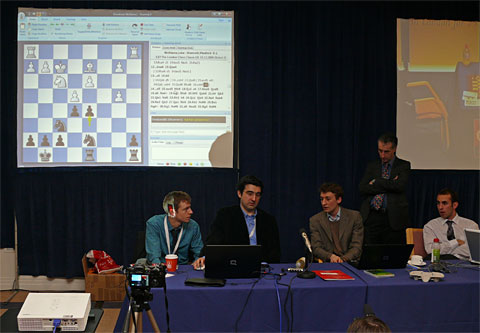
Both Vladimir Kramnik and Luke McShane analyse the game for the London
audience
and Playchess (with GM Stephen Gordon, IM Malcolm Pein and IM Lawrence Trent
following)
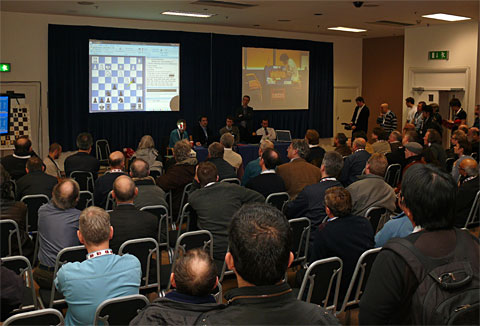
A full house at these post-game analysis sessions
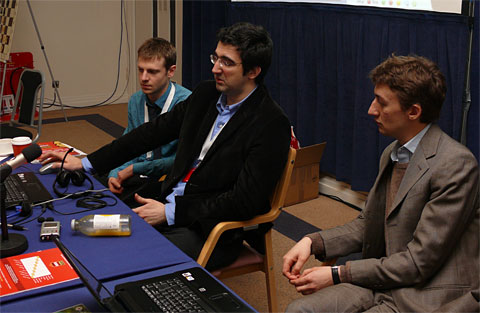
Vladimir Kramnik is remarkably agile when showing moves and lines with Fritz
Nakamura-Short started with a slightly offbeat variation of the Nimzo-Indian Defence, with Nigel Short’s 7...Nc6 not appearing in the books. Black played in accordance with ‘hypermodern’ principles for much of the game, i.e. allowing White to occupy the centre and targeting it from afar. Eventually there was a large number of pieces exchanged, reaching a clearly level rook and pawn endgame which the arbiter permitted the players to agree drawn.
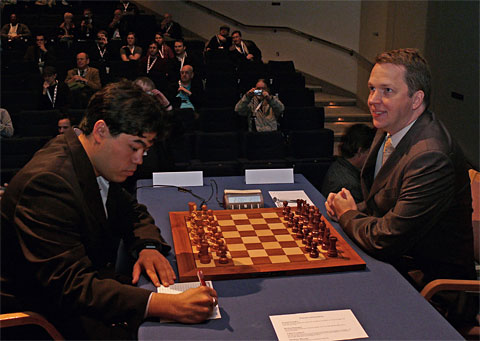
Nakamura,Hikaru (2715) - Short,Nigel (2707) E44
London Chess Classic London (3), 10.12.2009
1.d4 Nf6 2.c4 e6 3.Nc3 Bb4 4.e3 b6 5.Nge2 Ne4 6.Bd2 Nxd2 7.Qxd2 Nc6
8.a3 Be7 9.Nf4 Bg5 10.b4 Bb7 11.d5 Ne5 12.Rc1 0-0 13.Be2 a5 14.0-0 axb4 15.axb4
Bxf4 16.exf4 Ng6 17.Rfe1 c6 18.g3 cxd5 19.cxd5 Ne7 20.Bf3 Ra3 21.Be4 Qa8 22.Rcd1
h6 23.Qd4 Nxd5 24.Nxd5 Bxd5 25.Bxd5 Qxd5 26.Qxd5 exd5 27.Rxd5 Ra7 28.Rd6 Rb7
29.f5 f6 30.Red1 Rc8 31.Kg2 Rc4 32.R1d4 Rxd4 33.Rxd4 Rc7 34.Kf3 Rc2 35.h4 h5
36.Rd5 Rc4 37.Rb5 Rc6 38.Rd5 Rc4 39.b5 Rb4 40.Ke3 Kf8 41.Rxd7 Rxb5 42.Rb7 Rxf5
43.Rxb6 1/2-1/2. [Click
to replay]
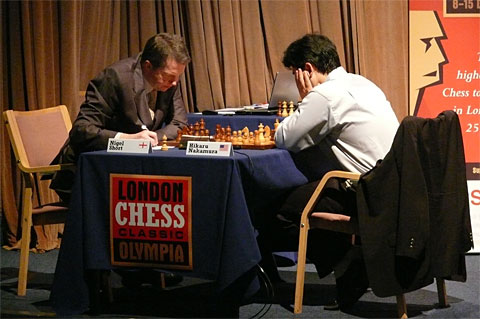
Britain vs USA, Nigel Short vs Hikura Nakamura in round three
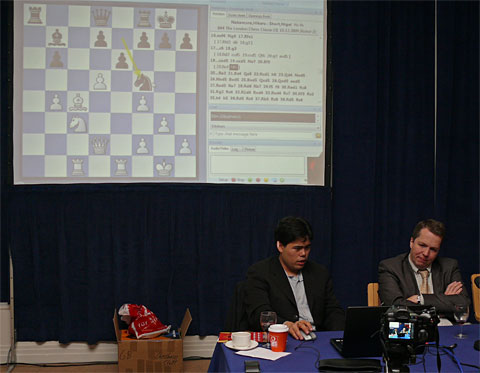
After the game Hikaru and Nigel analyse for the spectators
Howell-Carlsen was perhaps the most eagerly-awaited clash of the day. These two young men were both born in 1990, David Howell on 14 November and Magnus Carlsen on 30 November, so David is just 16 days older than Magnus. Incidentally, 1990 was a vintage year for chessplayers. As well as these two, there were Sergey Karjakin, Maxime Vachier-Lagrave, Dmirti Andreikin, Yuri Kuzubov and Ian Nepomnichtchi. David and Magnus have met twice before, once as 11-year-olds in the World Under-12 Championship of 2002 and once at a Budapest ‘First Saturday’ tournament the following year. On both occasions Magnus was White and both games were drawn. This time David went in for a rather unambitious line of the c3 Sicilian. In fact, it looked for a while as though he might go the same way as Luke McShane. It is a long game and we’ll just look at the turning points.
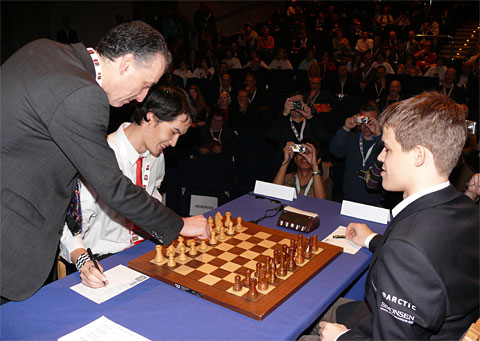
Tournament director Malcolm Pein executes the first move in Howell vs Carlsen
Howell,David (2597) - Carlsen,Magnus (2801) B22
London Chess Classic London (3), 10.12.2009 [John Saunders]
1.e4 c5 2.c3 d5 3.exd5 Qxd5 4.d4 Nf6 5.Nf3 e6 6.Be3 Be7 7.dxc5. Inviting a queen exchange. The pawn cannot be retained for any length of time so this line doesn't offer much hope of an opening advantage for White. 7...Qxd1+ 8.Kxd1 0-0 9.Nbd2 Ng4 10.Nb3 Nxe3+ 11.fxe3 Nd7 12.c6. White has to give the pawn back so decides the best he can do is to leave Black with an isolated c-pawn. 12...bxc6 13.Na5. Black ignores this threat to the pawn so it is probably a waste of time. 13...Bc5! 14.Nd4 If White takes the pawn with 14.Nxc6 Black will respond with something like 14...Bb7 15.Ncd4 Nf6 lining up e5 and a rook on the d-file. Even though there are no queens on the board, the white king will be in danger. 14...Nf6 15.Bc4 Ng4 16.Ke2 e5 17.Nc2 Bf5 18.h3 Nf6 19.Nb4 Be4 20.Nbxc6 Rfe8 21.Rhg1 Bb6
|
Notice how awkwardly placed the white knights are. If one moves, the other is lost. So White has to bring up reinforcements. 22.b4 Rac8 23.b5 Bxa5. That move surprised me. I expected Magnus to play something like 23...Rc7 followed by Rfc8, to increase the pressure on David's position. Magnus must have thought some tangible advantage would accrue from capturing on a5. 24.Nxa5 Rc5 25.a4 Rec8 26.Bd3 Bxd3+ 27.Kxd3 Rxc3+ 28.Ke2 Rc2+ 29.Kf3 e4+ 30.Kf4 R8c5
|
Magnus will have seen this quite some time before and must have judged it much better for Black, with the white king stranded in no man's land. However, White has some counterplay on the queenside. 31.Nc6! White's pl an is to take on a7, then push his queenside pawns, in the hope or expectation that Carlsen won't snare his king in a mating net in the meantime. David Howell was way behind on the clock, with only a few minutes to reach the 40th move, while Black had plenty of time in hand. 31...g5+ 32.Kg3 R5c3 33.Ne7+. White can perhaps play 33.Nxa7 Rxe3+ 34.Kh2 g4 35.Kh1 gxh3 36.gxh3+ and answer 36...Rxh3 "mate" by indicating that Black's king is already in check. But, with so little time, he wouldn't have wanted to risk this just in case he had missed something. 33...Kf8 34.Nf5 Nd5
|
35.Rge1? A time trouble blunder. 35...Nf4! 36.Rg1. White has to cede rook for knight. Black threatens mate in one. If 36.Kh2? Nxg2! will win material with a devastating discovered check. 36...Ne2+ 37.Kg4 Nxg1 38.Rxg1 f6 39.h4 gxh4 40.Kxh4 Ra3
|
The time control was reached, with Black having a material advantage of rook for knight. To be honest, you would expect the world number one to put this one away, but Magnus Carlsen's play from hereon looks tentative and unconvincing. Don't just take my word for it – here's what Magnus himself has to say on his Arctic Securities blog:
"The rest of the game after move 40 I would like to forget as soon as possible. Despite an extra pawn and the exchange, I struggled to make any progress due to his well coordinated pieces and good defence. I missed a fairly easy winning combination at move 52. In the end I gave up two pawns to try to activate my king but did not make progress. In the end a draw was agreed after 6,5 hours play. A disappointing result after the promising position I had around the first time control, but two wins and a draw still constitute an excellent start of the tournament when going into the free day."
Nice to see Magnus give David some credit for excellent defence. It is not easy to steel yourself to defend such a difficult position but the young Englishman did so very well. 41.g4 Rxa4 42.Rd1. Black now s rook and pawn for the knight - a very substantial material advantage - but that is not to say that it should be an easy win. If the world number one cannot win from here, it is, by definition, hard to win! One snag is that his king is slightly at the mercy of the white pieces, and another is that the knight on f5 is well placed. A third problem is that none of the pawns are passed or poised to advance. 42...Raa2 43.Rd7 Rh2+ 44.Kg3 Rhg2+ 45.Kh3 Rgf2 46.Nd4 Kg8? This raised eyebrows in the press room. What is he doing? 46...Ra3 looks more to the point. 47.Re7 Kf8 48.Rc7. We expected simply 48.Rxe4 but White too is finding it hard to figure out what to do. 48...Ke8 49.Kg3 Rf1 50.Rxh7 Ra3 51.Kg2 Rd1 52.Nf5?
|
White goes wrong. 52.Nc6 is probably better though Black may be able to win eventually. 52...Rd7? As David played 52 Nf5?, the move 52...Ra2+! flashed up on all the 'watching computers' of the world, which wins material for Black: after 53.Kg3 (53.Kh3 Rh1+ loses the rook on h7) 53...Rg1+ 54.Kf4 Rf2+ 55.Kxe4 Rxg4+ Black will be able to capture the knight next move. As well as missing the forced win, the text move spoils most of Magnus's remaining hopes of winning by more attritional methods. 53.Rh8+ Kf7 54.Kg3 Rb3 55.Kf4 Rb1. If 55...Rb4 56.Nd4 and White can win the e-pawn. 56.Kxe4 Rf1 57.Rh7+ Ke6 58.Rh8. 58.Ng7+ looks like a perpetual check, but White is reasonably comfortable anyway. The rest of the game can be skipped over quickly as Black has no realistic chance of winning any more. 58...Rc7 59.Nd4+ Kd6 60.Rd8+ Rd7 61.Rc8 Rg7 62.Rd8+ Rd7 63.Rc8 Re7+ 64.Kd3 Rc7 65.Rd8+ Rd7 66.Rg8 Rg1 67.Ke2 Kc5 68.Kf2 Rb1 69.Rf8 Rd6 70.Rf7 Rb2+ 71.Kf3 Ra2 72.Ke4 Kb6 73.Rf8 Rg2 74.Kf3 Rh2 75.Rb8+ Kc7 76.Ra8 Kb7 77.Rf8 Rh7 78.Kf4 Rh1 79.Kf3 1/2-1/2. [Click to replay]
As the players signed their scoresheets, Malcolm Pein took upon himself the lugubrious duty of informing the world number one what he had missed at move 52.
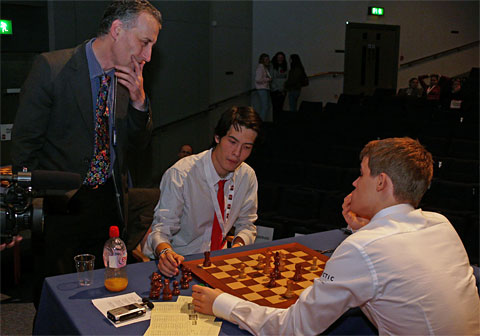
Malcolm Pein reveals the 52...Ra2+! win Fritz had found in the commentary
room
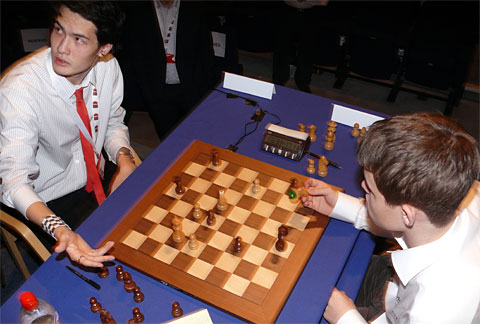
The players hadn't seen it and try to reconstruct the position at move 52...

... and are quite shocked to see the clever win they had both missed
Magnus took it pretty well, on the whole – a pained expression briefly crossed his face, and sotto voce he uttered the comment “that’s a bit embarrassing”. It broke his streak but he will come back refreshed after the rest day (Friday 11th). The last word must be for David Howell – he showed true grit to defend a horrendous position through two time scrambles. OK, ‘England’ lost the four-game ‘match’ by the odd point to the ‘Rest of the World’ but I think David’s performance on its own deserves the singing of a few choruses of the country’s favourite footie chant. All together now, everyone, there’s only word to learn: “Eng-er-land!, Eng-er-land!, Eng-er-land!...”
Pictures by Frederic Friedel in London
About the authorJohn Saunders started playing competitive chess at school in High Wycombe and was lucky enough to join the Cambridge University Chess Club when it was the strongest club in the UK. He studied law and classics at university and had a 20-year career as a public sector IT specialist before becoming editor of British Chess Magazine in 1999. As well as being editor, typesetter and webmaster for the magazine, he writes articles and takes photos. He is the regular webmaster/journalist for the Gibtelecom Chess Festival, and performed a similar function for the 2001-2007 Monarch Assurance Isle of Man Congresses and the 2008 European Union Championship in Liverpool. He writes the chess page for BBC TV’s Ceefax service. John plays hardly any chess these days but, when he did, he reached a FIDE Rating of 2255 and represented Wales in the 1997 European Team Championship. He is married, with two cats, and lives in Kingston-upon-Thames, Surrey. |
 |
|
Scoring System: 3 - Points per win 1 - Point per draw 0 - Points per loss |

|
|
||||||||||||||||||||||||||||||||||||||||||||
|
|
||||||||||||||||||||||||||||||||||||||||||||
|
|
||||||||||||||||||||||||||||||||||||||||||||
|
|
||||||||||||||||||||||||||||||||||||||||||||
| Monday | 7th December | Press Conference + blindfold display | |
Tuesday |
8th December |
Round 1 |
2.00pm |
Wednesday |
9th December |
Round 2 |
2.00pm |
Thursday |
10th December |
Round 3 |
2.00pm |
| Friday | 11th December | Rest day and Community / School events | |
Saturday |
12th December |
Round 4 |
2.00pm |
Sunday |
13th December |
Round 5 |
2.00pm |
Monday |
14th December |
Round 6 |
2.00pm |
Tuesday |
15th December |
Round 7 |
12.00pm |
LinksThe games will be broadcast live on the official web site and on the chess server Playchess.com. If you are not a member you can download the free PGN reader ChessBase Light, which gives you immediate access. You can also use the program to read, replay and analyse PGN games. New and enhanced: CB Light 2009! |